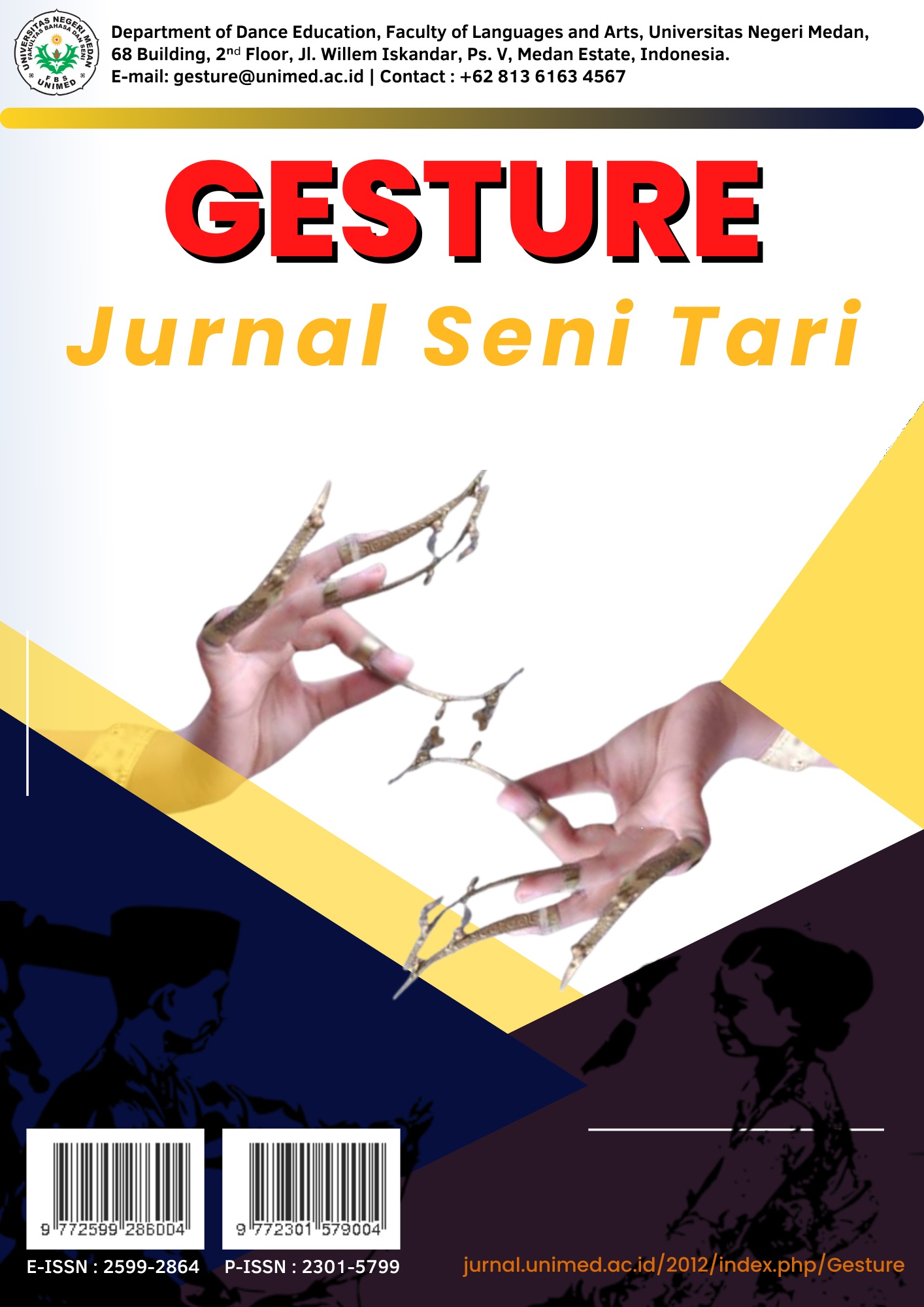Estetika Tari Betangas pada Sanggar Sultan Nata di Kabupaten Sintang Provinsi Kalimantan Barat
DOI:
https://doi.org/10.24114/gjst.v14i2.67462Abstract
The purpose of this study was to analyze the aesthetic value of Betangas dance at Sanggar Sultan Nata in Sintang Regency. Betangas dance is a new creative dance created by Musliyadi in 2014. Betangas dance uses basic Malay dance movements. This study is a qualitative study with an ethnochoreology approach and descriptive analysis method. Data collection techniques: observation, interviews, and literature studies. The aesthetic value in Betangas dance can be seen in the elements of movement, dance music, floor patterns, costume makeup and properties. The dance movements are inspired by the movements during the Betangas ceremony, the music uses Malay music, uses corrective makeup and costumes based on the Sintang Malay traditional dress, the properties used are woven pandan leaf mats and sarongs or tapeh. The aesthetics of Betangas dance are related to the life value of the Malay community, especially in Sintang Regency.References
Andiyanto. (2010). The Make Over Mata. Jakarta: PT.Gramedia Pustaka Utama.
Damayanti, I., Rahayu, T., (2024). Studi Komparatif Bentuk Penyajian Tari Serampang XII Versi Manuskrip. Gesture: JurnalSeni Tari, 13(2), 279-293. https://digilib.unimed.ac.id/id/eprint/58229/
Djelantik, A.A. M. (1999). Estetika Sebuah Pengantar. Bandung: Masyarakat Seni Pertunjukan Indonesia (MSPI).
Endinon, G. A. (2021). Bentuk Pertunjukan Tari Podang di Nagari Koto Nan Gadang Kota Payakumbuh. Gesture: Jurnal Seni Tari, 10(1), 83-94. https://journal.unnes.ac.id/sju/jst/article/view/46836
Erawati, Y., kurniawati, F., & Musrin. (2025). Tari Sirih Layang Masyarakat Suku Talang Mamak dari Ritual ke Seni Pertunjukan. Gesture: Jurnal Seni Tari, 14(1), 16-29. https://doi.org/10.24114/gjst.v14i1.65051
Friska, F. J., & Ikhsan, F. A., (2024). Pengembangan Waterfront Kawasan Istana Al Mukarammah Sintang. Senthong: Jurnal Ilmiah Mahasiswa Arsitektur, 7(3), 994-1007. https://digilib.uns.ac.id/dokumen/detail/115750/
Hendra, D. F., (2023). Kajian Dasar Bentuk Gerak Tari dan Musik Iringan Tari Zapin Penyengat. JPKS: Jurnal Pendidikan dan Kajian Seni, 8(2), 114-127. https://jurnal.untirta.ac.id/index.php/JPKS/article/view/19537
Irwansyah. (2020). Bentuk Penyajian dan Makna Gerak Tari Tradisional Rande di Kabupaten Sibaloga. Gesture: Jurnal Seni Tari, 9(2), 174-185. https://doi.org/10.24114/senitari.v9i2.19828
Meleong, Lexi. (1994). Metode Penelitian Kualitatif. Bandung: PT. Remaja Rosda Karya.
Mustaqim & Supriadi, D., (2025). Seni Pertunjukan Zapin Langkah 12 Desa Tanjung Balu Kecamatan Serasan Kabupaten Natuna Kepulauan Riau. Jurnal Tapak Melayu, 3(1), 82-91. https://jurnal.stainatuna.org/index.php/tapakmelayu/article/view/285
Nasution, A. F. (2023). Metode Penelitian Kualitatif. Bandung: CV. Harva Creative
Pane, H. (2020). Tradisi Pernikahan Adat Melayu Kabupaten Batubara. Pionir: Jurnal Pendidikan, 7(3), 989-1005. https://core.ac.uk/download/pdf/328163911.pdf
Prakoso, R. B., & Widyasutieningrum, S. R. (2025). Proses Kreatif dan Bentuk Karya Tari Golek. Gesture: Jurnal Seni Tari, 14(1), 1-15. https://doi.org/10.24114/gjst.v14i1.64940
Putri, D. P., Zuhud, E., Hermawan, R., & Tumanggor, R. (2017). Keanakaragaman Tumbuhan Untuk Bahan Betangas. Media Konservasi, 22(1), 87-91. https://core.ac.uk/download/pdf/230354476.pdf
Rianta, I. M., Santosa, H., & Sariada, I. K. (2019). Estetika Gerak Tari Rejang Sakral Lanang di Desa Mayong, Seririt, Buleleng, Bali. Mudra: Jurnal Seni Budaya, 34(3), 385-393. https://jurnal.isi-dps.ac.id/index.php/mudra/article/view/678
Soemaryatmi, S., & Darmasti, D. (2022). Topeng Ireng Dalam Acara Saparan di Desa Tarubangatang Kecamatan Selo Kabupaten Boyolali. Sitakara: Jurnal Pendidikan Seni dan Seni Budaya, 7(2), 163–177. https://jurnal.univpgri-palembang.ac.id/index.php/sitakara/article/view/9031
Suryawati, M. (2018). Estetika Tari Sekapur Sirih Sebagai Tari Penyambutan Tamu di Kota Jambi. Titian: Jurnal Ilmu Humaniora, 2(2), 365-377. https://mail.online-journal.unja.ac.id/titian/article/view/5290
Susanto, H., Triani, S. N., & Qomariah. (2021). Malay Culter in The Kingdom of Sintang. SeBaSa: Jurnal Pendidikan Bahasa dan Sastra Indonesia, 4(1), 90-106. http://e-journal.hamzanwadi.ac.id/index.php/sbs/article/view/2789
The Liang Gie. (1976). Garis Besar Estetik. Yogyakarta: Penerbit Karya Yogyakarta.
Widyastutieningrum, S. R, Sedyawati,E., & Saddhono, K. (2011). Sejarah tari Gambyong: seni rakyat menuju istana. Surakarta: ISI Press.
Downloads
Published
Issue
Section
License
Copyright (c) 2025 Rizka Fauziah, Sri Rochana Widyastutieningrum, Maharani Luthvinda Dewi

This work is licensed under a Creative Commons Attribution-ShareAlike 4.0 International License.
Authors published with the Gesture: Jurnal Seni Tari agree to the following terms:
- Authors retain copyright and grant the journal the right of first publication with the work simultaneously licensed under a Creative Commons Attribution License (CC BY-SA 4.0) that allows others to share the work with an acknowledgment of the work's authorship and initial publication in this journal.
- Authors are able to enter into separate, additional contractual arrangements for the non-exclusive distribution of the journal's published version of the work (e.g., post it to an institutional repository or publish it in a book), with an acknowledgment of its initial publication in this journal.
- Authors are permitted and encouraged to post their work online (e.g., in institutional repositories or on their website) prior to and during the submission process, as it can lead to productive exchanges, as well as earlier and greater citation of published work. (See The Effect of Open Access)








